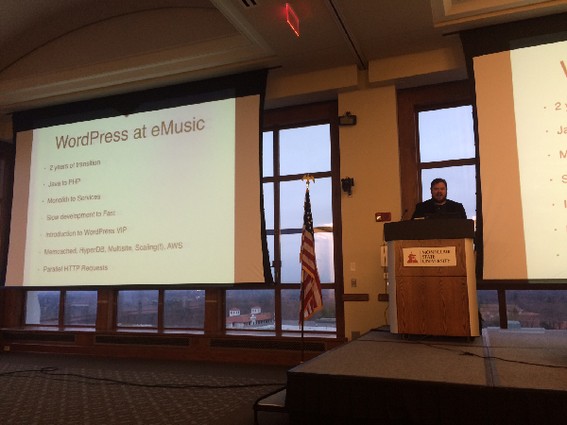Developer Tells Montclair Entrepreneurs How He Came to Write Code for WordPress

Did you know that WordPress powers 23 percent of the Internet? At the Monclair Entrepreneurs Meetup in early April, attendees learned more about why WordPress has such an impressive presence on the Web.
During his opening remarks and introduction of the WordPress panel, Jason Frasca, a Meetup co-organizer, told the group that WordPress was much more than a content management system or blogging platform. During the event, the audience learned about how to leverage WordPress for their own businesses.
One of the featured panel members was Scott Taylor, senior software engineer at The New York Times, who discussed his journey from being a musician to a WordPress guru.
“A lot of people come to WordPress in a lot of different ways, and end up making careers and livelihoods for themselves with WordPress,” he told the group. “It wasn’t that long ago that I didn’t know what WordPress was.”
Taylor explained the two different faces of WordPress. WordPress.com is the blogging platform that many people use, as it hosts blogs for free. It is maintained by a company called Automattic, which was founded by Matt Mullenweg, who also founded WordPress.
Mullenweg was an Open Source developer when he took WordPress in a second direction and created WordPress.org, Taylor said. Open Source means that anyone can contribute to the code, but he or she would have to be “a pretty skilled developer, passionate enough about it, or have enough knowledge” to do so. Taylor also noted that WordPress.org is an idealistic volunteer system that attracts people from all over the world.
WordPress developers communicate with each other through “Slack,” and track bugs through a tool called “Trac.” “If you find a bug within WordPress you can submit a ticket. There are people within Trac who will read the ticket and perhaps upload a fix to the software,” he said. The fix would then be incorporated into WordPress in the next release.
Taylor ended up becoming an expert in WordPress unexpectedly. While at college he majored in music, and took a music technology class in which the students learned how to make sheet music and very primitive websites. He made a primitive website about a recital that he was going to give. The following summer, one of the members of his band said that he wanted to create a website for the band, but he never did. Taylor ended up creating the website so he could post the band’s concert calendar. “I learned how to put a forum up and make a calendar, and each one of those projects took me a day.”
When the band broke up, Taylor moved to New York, and in order to earn money, he found an entry-level development job using Craigslist, which got his foot in the door and helped him master some HTML skills. He found his next job at the subscription music company eMusic, and stayed for five years. “This is where all my WordPress introductions came from,” said Taylor. He was learning a lot about WordPress, and seeing a lot of opportunity there.
During his time at eMusic, Taylor introduced WordPress to that company, and was able to transfer all of eMusic’s legacy systems to WordPress-based content management. “It made my skills better and made me the lead developer at eMusic after three years.
“I started using WordPress … and realized the power of the whole WordPress ecosystem. …For those who are not familiar with WordPress, there are plug-ins and themes,” he said. This means that if you want to start from scratch, you can make your own plug-ins and themes, but “a lot of times the problems you are trying to solve have already been solved by other people. …You have the ability to lean on free themes and free plug-ins to get you started. You don’t have to reinvent the wheel every time.”
Taylor noted that a plug-in called “BuddyPress” allows you to have a social network, while a plug-in called “Shopp” allows a website to have an e-commerce component. “You could have very little development experience, but as long as you could read code,” you could have an e-commerce connection on the site, he explained.
Taylor began attending WordCamps, where he physically met the people behind WordPress. “I was blown away by all of the resources in this community, ways to learn and network and ways to grow as a developer.”
As his skills improved, he found a job at The New York Times, which was using WordPress for a specific project. Fast-forward eight years to the present: He has since moved through several layers of positions as a “contributor” to WordPress, and is now considered a “committer,” which means that he can go into WordPress and insert patches himself.
“I don’t know how many of you have used WordPress, but for a couple of years there has been audio and video support in WordPress, and it wasn’t that easy before that. I wrote a lot of that code.” Taylor told the group. His next blockbuster release will be WordPress 4.0, for which he committed almost half the code.
Summing up his journey, Taylor told the group that WordPress makes things easier. “You know, back when I had my recital, I needed a base of HTML knowledge and I hand coded links to my MP3 file. Someone now could use WordPress, and their recital website would be really easy to create.”

